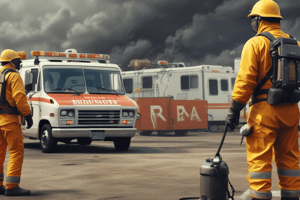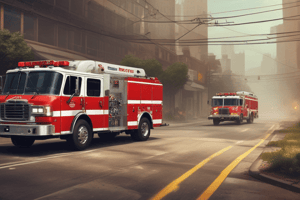Podcast
Questions and Answers
Which sources provide essential information during a Hazmat incident?
Which sources provide essential information during a Hazmat incident?
- Observations and victim accounts (correct)
- Emergency response vehicles only
- Government regulations and guidelines
- Physics textbooks and studies
What information does the Emergency Response Guidebook (ERG) include?
What information does the Emergency Response Guidebook (ERG) include?
- Substance properties and hazard identification (correct)
- Only emergency contact numbers
- Historical data on past incidents
- Guidelines on chemical manufacturing
Which class corresponds to flammable solids in the DOT classification system?
Which class corresponds to flammable solids in the DOT classification system?
- Class 6
- Class 1
- Class 4 (correct)
- Class 7
What is the purpose of placards in the USD marking system?
What is the purpose of placards in the USD marking system?
Which document provides transport details for Hazmat carried by trucks?
Which document provides transport details for Hazmat carried by trucks?
What distinguishes labels from placards in Hazmat transport?
What distinguishes labels from placards in Hazmat transport?
How many chemical families are recognized in the DOT classification system?
How many chemical families are recognized in the DOT classification system?
Which marking requirement is true regarding Hazmat shipments?
Which marking requirement is true regarding Hazmat shipments?
What type of information is essential for KEMRA when dispatched?
What type of information is essential for KEMRA when dispatched?
In the NFPA 704 marking system, what does the red diamond represent?
In the NFPA 704 marking system, what does the red diamond represent?
What information does a Safety Data Sheet (SDS) typically provide?
What information does a Safety Data Sheet (SDS) typically provide?
What does a hazard level of 0 indicate in the NFPA 704 system?
What does a hazard level of 0 indicate in the NFPA 704 system?
Which information about the recipient is essential for KEMRA to gather?
Which information about the recipient is essential for KEMRA to gather?
Study Notes
Hazmat Incident Information Sources
- Observations, reports from bystanders, and victim accounts provide vital information during a Hazmat incident.
- Look for labels, placards, shipping papers, and Safety Data Sheets (SDS) for hazard specifics.
- Emergency response vehicles must carry the most recent edition of the DOT Emergency Response Guidebook (ERG) for reference, available as a mobile app.
Emergency Response Guidebook (ERG)
- ERG contains critical information on substance properties and hazard identification.
- It includes placard meanings and recommended isolation distances.
- Nine recognized chemical families are classified as DOT Class 1 through 9:
- Class 1: Explosives
- Class 2: Gases
- Class 3: Flammable and combustible liquids
- Class 4: Flammable solids, spontaneously combustible materials, water-reactive substances
- Class 5: Oxidizing substances, organic peroxides
- Class 6: Toxic and infectious substances
- Class 7: Radioactive materials
- Class 8: Corrosive substances
- Class 9: Miscellaneous hazardous materials
Hazard Marking Systems
- The USD marking system employs labels, placards, and markings for Hazmat transport in the U.S. and Canada.
- Placards are diamond-shaped indicators placed on vehicles to represent broad hazard classes.
- The United Nations and North American coding system employs four-digit numbers for specific Hazmat identification.
- Labels are smaller than placards and indicate hazards specific to smaller packages.
Minimum Marking Requirements
- Not all chemical shipments require placarding; specific quantities of Hazmat must be present.
Documentation for Hazard Identification
- Bill of lading or freight bill carried by the truck driver provides transport details.
- Waybill or manifest used for rail transport outlines Hazmat specifics.
- Dangerous cargo manifest and air bills provide information for maritime and air transport, respectively.
Additional Resources
- Dispatchers can gather information from sources like KEMRA, which has a comprehensive chemical database.
- Essential information for KEMRA includes:
- Chemical name, caller identification, incident location, shipper/manufacturer info, container type, carrier name, recipient details, local conditions, and situation description.
Fixed Facility Marking Systems
- NFPA 704 system features a placard with four diamonds indicating specific hazards.
- Red: Fire hazard level
- Blue: Health hazard level
- White: Special information
- Yellow: Reactivity hazard level
- Hazard levels rated from 0 (no hazard) to 4 (high risk).
Safety Data Sheets (SDS)
- Obtain SDS from permanent facilities for detailed hazard information.
- SDS provides chemical composition, potential hazards, first aid measures, and safe handling instructions.
Hazmat Incident Information Sources
- Observations and victim accounts are crucial for assessing Hazmat incidents.
- Important documents include labels, placards, shipping papers, and Safety Data Sheets (SDS) for understanding hazards.
- Emergency response vehicles should carry the latest DOT Emergency Response Guidebook (ERG) for immediate guidance; available as a mobile app.
Emergency Response Guidebook (ERG)
- ERG provides essential information on hazardous substance properties and identification.
- It contains meanings of placards and guidelines for recommended isolation distances.
- Classifications under DOT include:
- Class 1: Explosives
- Class 2: Gases
- Class 3: Flammable and combustible liquids
- Class 4: Flammable solids, spontaneously combustible materials, water-reactive substances
- Class 5: Oxidizing substances, organic peroxides
- Class 6: Toxic and infectious substances
- Class 7: Radioactive materials
- Class 8: Corrosive substances
- Class 9: Miscellaneous hazardous materials
Hazard Marking Systems
- The USD marking system uses labels, placards, and markings for Hazmat transport in the U.S. and Canada.
- Diamond-shaped placards on vehicles indicate broad hazard classes.
- The UN and North American coding system uses four-digit numbers for precise Hazmat identification.
- Labels convey specific hazards associated with smaller packages.
Minimum Marking Requirements
- Not all chemical shipments must be placarded; only those above specific Hazmat quantity thresholds require marking.
Documentation for Hazard Identification
- The bill of lading or freight bill carried by truck drivers details transport specifics.
- For rail transport, a waybill or manifest provides Hazmat information.
- Dangerous cargo manifests and air bills convey information for maritime and air transport respectively.
Additional Resources
- Dispatchers can utilize KEMRA, a chemical database, for gathering information.
- Key details in KEMRA include chemical name, incident location, type of container, carrier name, and situation description.
Fixed Facility Marking Systems
- NFPA 704 system features a placard with colored diamonds indicating specific hazard types:
- Red signifies fire hazard level.
- Blue indicates health hazard level.
- Yellow signifies reactivity hazard level.
- White represents special hazards.
- Hazards rated from 0 (no hazard) to 4 (high risk).
Safety Data Sheets (SDS)
- SDS must be obtained from facilities for comprehensive hazard details.
- SDS includes chemical composition, potential hazards, first aid instructions, and handling guidelines.
Studying That Suits You
Use AI to generate personalized quizzes and flashcards to suit your learning preferences.
Description
Explore essential information sources during a Hazmat incident, including observations, labels, and the role of the Emergency Response Guidebook (ERG). This quiz covers chemical classifications, hazard specifics, and recommended safety precautions. Test your knowledge on how to effectively respond to hazardous materials emergencies.




